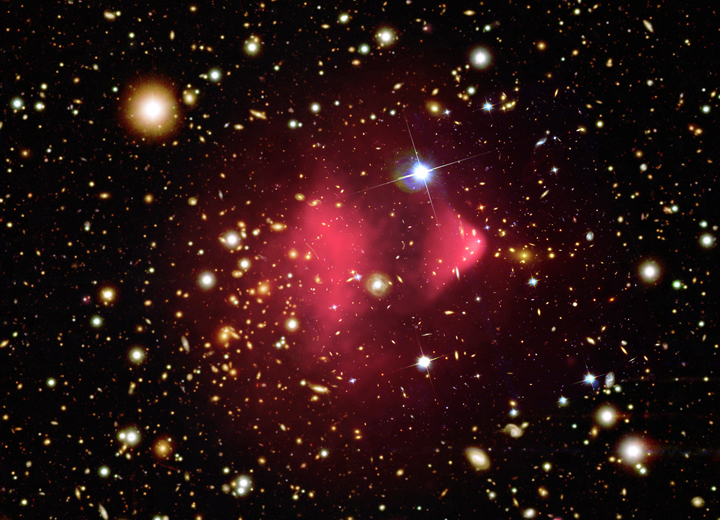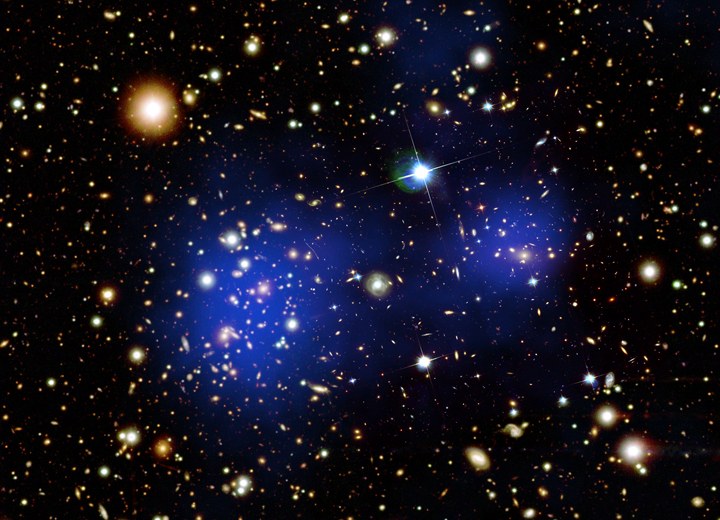
This is the Bullet Cluster at optical wavelenghts, the bunch of galaxies in the upper right form one of the two interacting subclusters, in the bottom left corner you can the second (and smaller) interacting cluster.
The concept of dark matter isn't really that new, it was proposed by Fritz Zwicky in 1933 who realized from observations of the Coma Cluster that the speeds of the galaxies in the cluster were too high to keep the cluster bounded, he realized the mass of the cluster should be 400 times greater to keep it together and although later observations showed some of this mass there was still less than the required to explain the motions of the galaxies. We have now evidence in many clusters, also the mass infered from gravitational lensing is always bigger than the mass from the observed galaxies, even in our own milky way the stars in the outer regions of the spiral disk orbit at higher velocities than we should expect from the observed mass.
There are two straightforward ways to explain this observations:
- There is more mass than we observe, this can be because it cames in the form of cold objects than don't emit much light (like the funny named MACHOs and brown dwarfs) or from some kind of matter that interacts very weakly with "normal" (baryonic) matter (these are called WIMPS, an obvious and funny match for the rival of baryonic matter). The latter explanation is much favored because the MACHOs and brown dwarfs seem to contribute only a small fraction of the missing mass.
- We need to modify the laws of gravity, a particular popular model of this type involves a modification of inverse square depence of gravity and is called MOND. Despite its problems in explaining some observations regarding gravitational lensing it was (until this morning) a more or less viable explanantion.
After observations with the Chandra X Ray Telescope Markevitch et al (1,2) it was possible to observe the gas component of the cluster (in clusters of galaxies most of the mass -around 90%- is in the form of a very hot gas that emits x rays) and it showed clear evidence of a recent interaction between the two clusters. This collision heated the gas even more, as far as I know this is the hottest known cluster.
 The Bullet Cluster in x rays is shown in the pink zone of the picture. Two shock front on the right corresponds to the smaller cluster, this front has the highest mach number of all the known intergalactic medium
The Bullet Cluster in x rays is shown in the pink zone of the picture. Two shock front on the right corresponds to the smaller cluster, this front has the highest mach number of all the known intergalactic medium
The most interesting part comes now, the galaxies in the clusters actually don't crash and rather pass by without changing that much, but the remaining matter in the gas forms about 90% of the mass of the cluster and we can use the x ray observations to see if the source of gravity points in the same direction where most of the observable mass is located. What makes the Bullet Cluster so special is that the galactic component is separated from the gas element, as dark matter (by definition) interacts very weakly if it interacts at all it will be in a position similar to the galactic component that passes almost unperturbed the interaction.
But how can we know where gravity comes from? One of the most surprising predictions of Einstein's theory of general relativty is that gravity can bent light in the so called gravitational lenses, the paper by Clowe et al (3) shows the weak lensing map of the bullet cluster maping the location of the mass in the cluster.
 The blue part of the picture maps the position of the matter causing the weak lensing in the background galaxies. As it turns out it is a map of the dark matter of the cluster!
The blue part of the picture maps the position of the matter causing the weak lensing in the background galaxies. As it turns out it is a map of the dark matter of the cluster!
Now, if you expect that the laws of gravity should be modified to explain the rotation curves in galaxies and the motions of galaxies inside clusters then you should expect at least that the weak lensing map points in the same direction of the observed matter, after all it's gravity should produce the weak lenses. It turns out that both the weak lensing and xray maps are well separated with the weak lensing map in the same position of the galactic component just as expected from dark matter!

This image shows the x ray emission in pink and the position of the mass causing the weak lenses in blue, as you can see most of the mass of the cluster is not in the observed xray emission and is actually just in front of the observed galaxies clearly showing that it has not interacted with the hot gas component. If this is not convincing enough for you then anything will be.
This shows conclusively that most of the matter in the Bullet Cluster is not in the observed x ray emission (and much less in the observed galaxies) but in an "invisible" component that only manifests through its gravitational presence. You can see here an animation of how we think this process happened. There is simply no way to fit any alternative theory of gravitation in it, the principal source of gravitational mass is simply not observed in any light wavelenght. Regarding the composition of dark matter this is one of the biggest unsolved problems in astronomy and physics, my personal guess is that is composed mostly of axions and light supersymmetric particles (the lightest supersymmetric partner turns out to interact really weaky and is stable as it can't decay into a lighter particle), but again it's just my guess.
Images courtesy of NASA, you can see more images here.
2 comments:
Nice blog and it is sad that the result was a bit shadowed by the Pluto discussion.
Few comments. The lensing technique used
in the Bullect Cluster paper suporting
DM is Weak Lensing, not microlensing.
Microlensing porduces only brightness changes while weak lensing produce image
distorions (weak ones).
Other than that it is a cool article. Given that most of
the baryonic matter in clusters is usually
in gas, the mismatch between hot gas and
the center of the gravitational lens, makes the situation difficult for a modified gravity theory. An undetected
cold filament of baryons might do the job
(look for MacGaugh coments). For that reason the verification of the result in
other systems could be important.
Also the detecion of the DM particle.
Thanks for the interesting Blog.
Sure, it's weak lensing, microlensing it's actually a technique for detecting extrasolar planets by measuring the change in brightness in it's host star.
Thanks for the correction.
Post a Comment